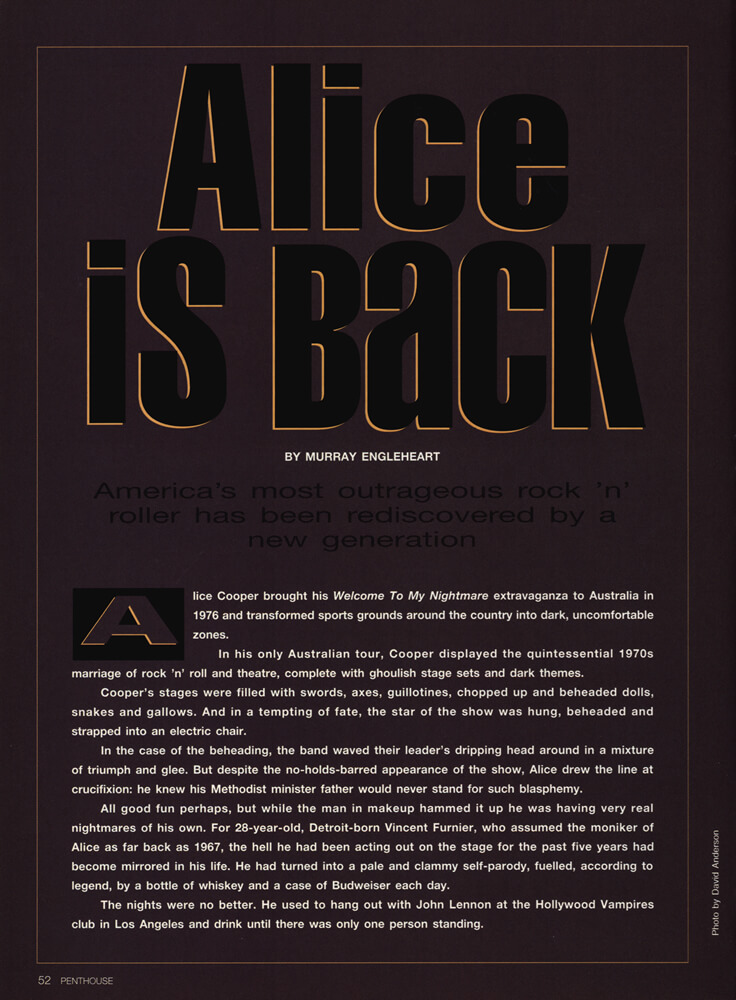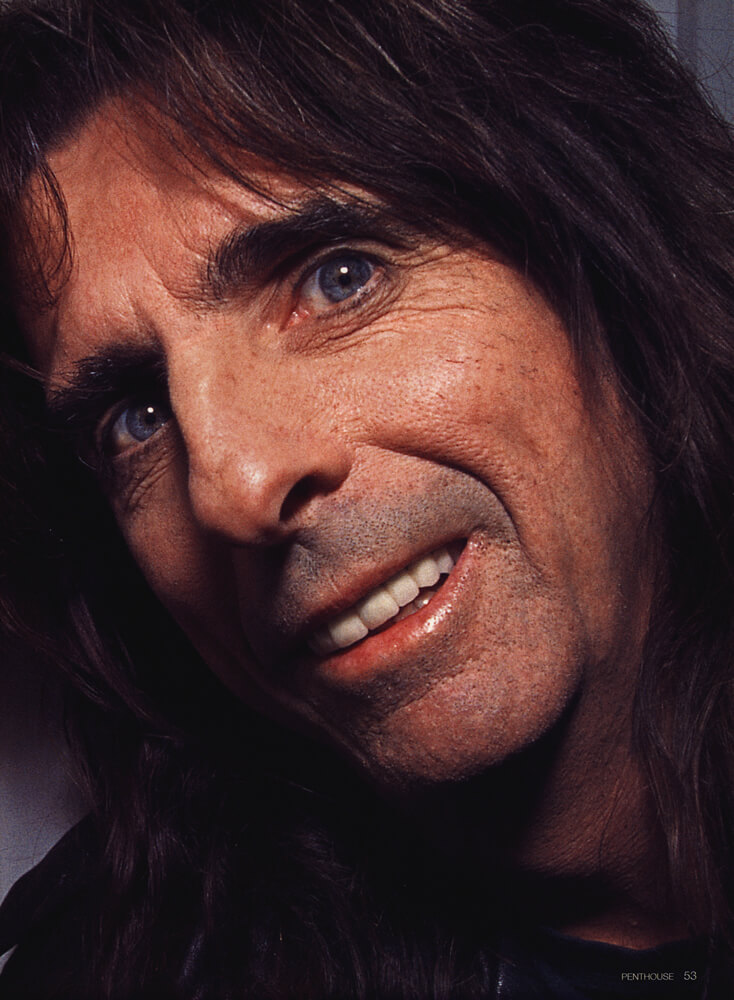Article Database

Penthouse
January 1995
Alice is Back
America's most outrageous rock 'n' roller has been rediscovered by a new generation
Author: Murray Engleheart
Alice Cooper brought his Welcome To My Nightmare extravaganza to Australia in 1967 and transformed sports grounds around the country into dark, uncomfortable zones.
In his only Australian tour, Cooper displayed the quintessential 1970s marriage of rock 'n' roll and theatre, complete with ghoulish stage sets and dark themes.
Cooper's stages were filled with swords, axes, guillotines, chopped up and beheaded dolls, snakes and gallows. And in a tempting of fate, the star of the show was hung, beheaded and strapped into an electric chair.
In the case of the beheading, the band waved their leader's dripping head around in a mixture of triumph and glee. But despite the no-holds-barred appearance of the show, Alice drew the line at crucifixion: he knew his Methodist minister father would never stand for such blasphemy.
All good fun perhaps, but while the man in makeup hammed it up he was having very real nightmares of his own. For 28-year-old, Detroit-born Vincent Furnier, who assumed the moniker of Alice as far back as 1967, the hell he had been acting out on the stage for the past five years had become mirrored in his life. He had turned into a pale and clammy self-parody, fuelled, according to legend, byu a bottle of whiskey and a case of Budweiser each day.
The nights were no better. He used to hang out with John Lennon at the Hollywood Vampires club in Los Angeles and drink until there was only one person standing.
By the end of the Welcome To My Nightmare tour, Cooper's excessive lifestyle was coming back to haunt him like one of his stage-bound ghouls.
Welcome To My Nightmare marked the peak of Alice Cooper's commercial success — thanks to songs like "Only Women Bleed" and "Department Of Youth" — but while the money and fame grew, he was going into a personal and physical decline. By the time 1979 rolled around, Alice Cooper had become a parody of a rock 'n' roll parody; and his tragic "Lost Decade" was about to begin, like a submarine going under for ten years.
Now, almost 20 years after being the biggest thing in show biz, 46-year-old Alice Cooper is talking about another tour, one that will hopefully include shows down-under. It will be a chance for a whole new generation of Australians to wonder whether or not to believe their eyes.
Mind you, Cooper had always pushed at the limits of believability. His first major recording royalty cheque had been for a staggering US$100,000: an unheard-of sum for a new act in those days. Just two years later, in 1973, his Billion Dollar Babies album tour was declared the highest grossing tour in rock history.
But money-making isn't the only reason Alice Cooper is mentioned in hushed, hallowed terms even today. Fellow musicians are more likely to point to the influence the veteran rocker has had on popular culture in the past 25 years; an influence he still exerts.
The entire concept of stage pyrotechnics is inconceivable without Alice Cooper. Likewise, 1970s supergroup KISS followed largely on Cooper's coat-tails.
He was acting a glazed-eyed, grinning psychotic 20 years before Kurt Cobain feigned vacancy in Nirvana's "Smells Like Teen Spirit" and Sex Pistols' Johnny Rotten and Sid Vicious used to play Cooper's "I Love The Dead" in the London underground.
Frank Sinatra covered his tear jerker, "You And Me" and Bon Jovi, in an ultimate act of tribute, wrote "The Ballad Of Alice Cooper".
He took an awestruck Guns 'n' Roses on their debut tour and had to bail the band out of gaol every night so they could play. The Gunners in turn had Alice duet with Axl Rose on "The Garden" from the Use Your Illusion I album.
Then there was his 1991 album, Hey Stoopid, featuring guests like Slash, Black Sabbath's Ozzy Osborne, Mick Mars from Motley Crue and guitar demi-gods, Steve Vai and Joe Satriani.
Alice Cooper even played Freddie Kruger's father in one of the Nightmare On Elm Street flicks and played himself in the blockbuster, Wayne's World.
Legendary surrealist, Salvador Dali, called him "an exponent of total confusion" and made a sculpture of Cooper's brain as a surgical aid with a chocolate eclair protruding from it. The pair later filmed the world's first three dimensional, moving hologram.
Another admirer was Groucho Marx. "Groucho used to call up at like two in the morning because he couldn't sleep. He'd say, 'Come on over, let's watch TV'.
"He'd be propped up in his bed and he'd have a six pack of Budweiser for me and we'd watch old movies. He'd tell me, 'See that guy over there that's playing the cop? Well, he was gay and he was doing that guy over there. And see that girl there? All of us got her'.
"After three or four hours I'd look over and he'd be asleep, so I'd put his cigar out and leave.
"One of the greatest compliments I ever got was when he said, 'Alice Cooper is the last chance at burlesque and vaudeville'."
In the early 1960s, Cooper formed The Earwigs, The Spiders and then The Nazz with his high school classmates in Phoenix, Arizona.
Their repertoire was largely based on Rolling Stones songs. The Spiders fore-shadowed some of the theatrics to come when Cooper played the band's first show from a bathtub and the band themselves blasted it out from behind a spider's web.
The mutation process had begun. By the time the band moved to Los Angeles, they were the direct antithesis of the times, wearing makeup, dressing in drag and for all the ham-fisted femininity, intimidating audiences right out the door. All at the urging of the creature that was Alice.
"To me it was natural that Alice not be a normal terrestrial creature," Cooper explains. "He had to be something other than human and he was other than human."
The late Frank Zappa was mightily impressed when Cooper's band cleared a 2000-strong audience out of LA's Cheetah Room during a show with The Doors and he promptly signed them to his weirdo label, Straight. The result of the Zappa alliance was two albums, Pretties For You in 1969 and Easy Action which followed in 1970. Both were later reissued as a double set called School Days and included such twisted gems as "Refrigerator Heaven".
In 1971 everything connected when the Love It To Death album was produced by Bob Ezrin who would later work with KISS on their milestone Destroyer album. Love It To Death featured a fabulous tribal version of Rolf Harris's "Sun Arise" and mapped out what was to be the Alice Cooper blueprint with tales of insanity, voodoo, black magic and sex.
The single "I'm 18" — which Johnny Rotten howled to when he auditioned for the Sex Pistols — was a hit in the United States and the Alice juggernaut was off and running.
"We were the loudest and most absolutely in-your-face rock 'n' roll band," Cooper declares proudly.
"All we cared about were blondes, booze, fast cars, switchblades and our music. That was it. We were really all American. We were the American dream. We were the American nightmare.
"They would always warn the audience three acts in advance that Alice Cooper was coming on so that anybody who was on bad acid could start gravitating towards the Red Cross tents. They would say Jefferson Airplane is coming up and The Grateful Dead and Santana and, Warning! Warning! Alice Cooper is coming on at 11 o'clock. It would drive people over the edge.
"We had no philosophy, we had no agenda. Our job was to absolutely destroy them and make them talk about us the next day."
The Killer album was released in 1971 and kept the conversations going but it was the School's Out album and song in 1972 that meant serious pay dirt. The album was packaged as a school desk complete with wads of old chewing gum and inscriptions. The record itself was wrapped in a pair of paper panties. This time the theatrics made it onto record with the Westside Story angle of "Gutter Cats vs The Jets", which ended in a simulated street fight.
"Our show was very dangerous if you were in the wrong place at the wrong time. The fight scene was a fight scene, we didn't pull any punches. People thought it was fake blood, but a lot of times it wasn't.
"I broke a lot of things," he grins recalling some of his stage injuries. "I had six broken ribs at one point, I broke this arm, I had a 20-inch gash in my head and I put a sword through my leg one time accidentally — I mean right through it."
He unwittingly assisted his old Detroit buddy, Iggy Pop, to do himself some harm when he gave Mr Pop a stiletto blade he had bought in Europe.
"He got on stage that night and he started cutting himself up. Just little cuts, but he got really carried away and we had to wrap him in a blanket and take him to hospital afterwards.
"After that I said, 'I'm not going to give you any more pointed toys'," he laughs.
Another of Alice's late night manic companions was Keith Moon, The Who's celebrated drummer.
"He used to come over to the house and he was so whacked out most of the time. He was so intense you had to get away from him for a while, so I would sneak out and come back two days later and he was still there! He had his huge Rolls Royce that was like a classic, long, black, stately Rolls Royce and there was nothing in it. All the seats were taken out except the back and he had a throne put in with velvet and his goblet that held his brandy — this solid gold goblet, so when you looked in the Rolls Royce he would be sitting back there and he was the king.
"He was such a sweetheart, but absolutely as mad as a hatter. He was almost too big. He lived his life too big."
Too big was almost what 1973's Billion Dollar Babies album and subsequent tour became, with a stage show featuring live flames and dollar bills falling onto the crowd.
The album's green snake skin cover and shots of babies in black corpse-like makeup, just like their Uncle Alice, set the singer's mascara in cement. Inside, the songs were symphonies of horror rock like "Sick Things", "I Love The Dead" and the hit "Elected" in which Alice mockingly ran for presidential office. "I'd have to take a huge cut in pay," he cackled.
The following album, Muscle Of Love may have been the first cock rock album. Some versions of it came in a cardboard container but good as it was, there didn't seem to be a concept to base a stage show on and Alice-mania waned.
The following year, Alice hit back with the massively successful concept album, Welcome To My Nightmare, with its tales of necrophilia and dementia.
That album marked his first recording without his band mates from school days and also marked the year Cooper's lifestyle caught up with his body.
From there, a few moments on 1976's Alice Cooper Goes To Hell notwithstanding, it was for the most part downhill thanks to the excesses of drink.
On one album sleeve, Alice was clearly gaunt and ill, even under the makeup. The classic raunch 'n' roll was replaced with dumb and predictable heavy metal and the once riveting show was reduced to the lowest common shock denominator without any class or mad genius.
More than a decade later, it took a teen movie, Wayne's World, to renew interest in Cooper. The movie's box office success synchronised perfectly with the massive success of the Trash album in 1989 with songs like "Poison" and "Bed Of Nails" and was followed by the 1991 Hey Stoopid album.
Now, with The Last Temptation, Alice Cooper has come full circle in a return to the concept album days of Welcome To My Nightmare. The latest album even comes with a lavish comic book depicting Alice as a perverted sideshow spruiker.
The biblical overtones in the title are no accident. Alice attends church every Sunday these days and wears a large cross around his neck. But The Last Temptation also has its share of classic Alice Cooper teen punk anthems like "Lost In America". And, no doubt, when the stage show is conceptualised, it will look every inch of the estimated $1 million budget it costs to get an Alice Cooper show rehearsed and on the road.
In the meantime the props of yesteryear remain locked in an eerie warehouse in Los Angeles, awaiting yet another lease on life from the rock legend who is still larger than life.
(Originally published in the Austrian version of Penthouse magazine, January 1995)






